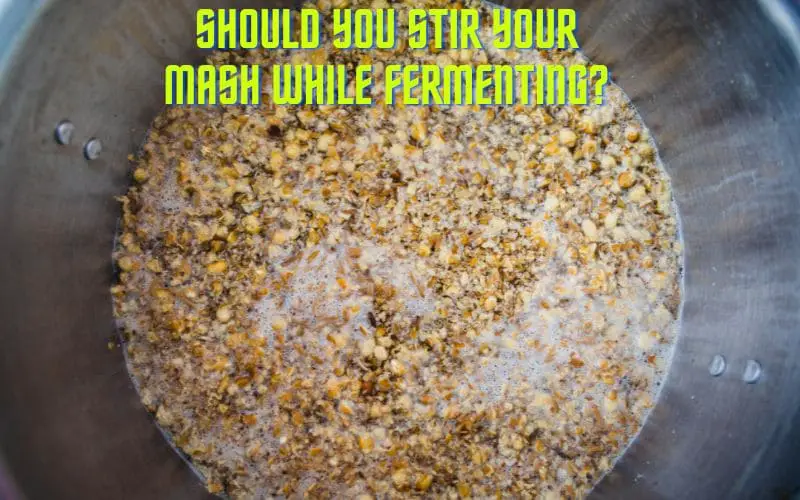Should You Stir Your Mash While Fermenting? Lets Take A Look

Introduction
Welcome to the world of moonshine, where tradition, craftsmanship, and innovation converge to create a unique experience. In this article, we explore the age-old question: Should you stir your mash while fermenting? The answer to this question has been a topic of discussion among moonshine enthusiasts, and we aim to delve into the benefits, drawbacks, and best practices related to stirring the mash during fermentation.
Answer to the Question
Before we dive into the specifics, the answer isn’t a simple yes or no. The decision to stir the mash during fermentation depends on various factors, including the type of mash, environmental conditions, and the desired outcome. Let’s explore this topic further to understand the nuances and considerations involved in making this crucial decision.
Benefits of Stirring the Mash
Improves Yeast Activity
Improves Yeast Activity
- Enhances yeast growth and reproduction
- Increases the conversion of sugars to alcohol
- Boosts the production of flavor compounds
Stirring the mash during fermentation plays a crucial role in improving yeast activity. It enhances yeast growth and reproduction by ensuring a more uniform distribution of nutrients and sugars. This promotes a healthier fermentation process, leading to higher alcohol yields and improved flavor profiles.
Even Distribution of Heat
Even Distribution of Heat
Stirring the mash not only improves yeast activity but also plays a crucial role in ensuring the even distribution of heat throughout the fermentation vessel.
- This even distribution of heat is essential in preventing localized hot spots, which can have detrimental effects on the fermentation process.
- Localized hot spots can lead to uneven fermentation, resulting in potential off-flavors and inconsistencies in the final product.
Furthermore, by maintaining a consistent temperature distribution, the quality and consistency of the moonshine can be greatly improved.
Drawbacks of Stirring the Mash
Risk of Contamination
One of the primary drawbacks of stirring the mash is the potential risk of contamination. Introducing foreign microorganisms or bacteria during stirring can disrupt the fermentation process and compromise the desired flavors and aromas. Careful consideration and sanitation practices are essential to mitigate this risk.
Contamination can occur from various sources, and being aware of these potential contaminants is crucial for maintaining the quality of the brew. Some common sources of contamination include:
- Unsanitized brewing equipment and containers
- Introduction of wild yeast or bacteria from airborne sources
- Untreated water or unclean brewing ingredients
When contamination occurs, it can lead to unwanted off-flavors, inconsistent fermentation, and undesirable characteristics in the final product. This can be a significant setback for brewers, especially when aiming for a specific flavor profile.
To minimize the risk of contamination, brewers should adhere to the following preventive measures:
- Thorough sanitation of all brewing equipment and containers
- Use of quality brewing ingredients from reliable sources
- Proper handling of yeast and maintaining a clean brewing environment
Aeration Concerns
Stirring the mash can introduce oxygen into the fermentation vessel, leading to aeration concerns. While oxygen is beneficial during the initial stages of fermentation, excessive exposure to oxygen during later stages can negatively impact the flavor and quality of the moonshine. Balancing aeration levels is crucial to maintain the desired characteristics of the final product.
- Impact of Oxygen in Fermentation
- During fermentation, yeast requires oxygen for growth and reproduction. The initial introduction of oxygen facilitates the yeast’s metabolic processes, leading to a vigorous fermentation process. However, as the fermentation progresses, excessive oxygen exposure can lead to off-flavors and aromas, compromising the moonshine’s quality.
- Managing Aeration Levels
- To minimize the risk of aeration-related issues, it’s essential to control the aeration levels throughout the fermentation process. This can be achieved by stirring the mash gently during the initial stages and reducing agitation as fermentation progresses. Additionally, using specialized equipment such as airlocks can help regulate oxygen exposure while allowing for the release of carbon dioxide.
Best Practices for Stirring the Mash
Frequency of Stirring
Stirring the mash is a crucial step in the brewing process that directly impacts the outcome of the beer. The frequency of stirring plays a significant role in promoting efficient fermentation and achieving the desired flavor profiles. Here are key considerations for determining the frequency of stirring:
- Recipe Requirements: Different recipes may call for varying stirring frequencies based on the specific grains, malts, and adjuncts used. Heavier or denser ingredients may require more frequent stirring to ensure even distribution and consistent enzymatic activity.
- Yeast Strain Characteristics: The characteristics of the yeast strain employed can influence the optimal stirring frequency. Some yeast strains may require more frequent agitation to prevent settling, while others may thrive with less frequent stirring.
- Environmental Conditions: Ambient temperature and humidity levels can impact the rate of fermentation. Considering these factors is essential when determining the frequency of stirring, as they can affect the metabolic activity of the yeast.
Establishing a well-defined stirring schedule is essential for maintaining a healthy fermentation environment and encouraging the yeast to efficiently transform fermentable sugars into alcohol and flavorful byproducts. However, it’s important to strike a balance, as over-stirring can lead to unnecessary aeration, which may negatively impact the fermentation process and beer quality.
Tools for Stirring
When it comes to stirring the mash, using the right tools is essential. Long-handled spoons, paddles, or specialized stirring instruments are commonly employed to reach the depths of the fermentation vessel and ensure thorough mixing without causing excessive disturbance. Careful attention to sanitation and hygiene during the handling of stirring tools is paramount to maintaining a clean fermentation environment.
Conclusion
In conclusion, the decision to stir the mash while fermenting is influenced by a delicate balance of factors, including yeast activity, temperature distribution, contamination risks, and aeration concerns. By weighing the benefits and drawbacks, moonshine enthusiasts can make informed choices and adopt best practices to optimize the fermentation process. Whether to stir or not to stir ultimately depends on the specific conditions and desired outcomes, emphasizing the nuanced nature of the art and science of moonshine production.
